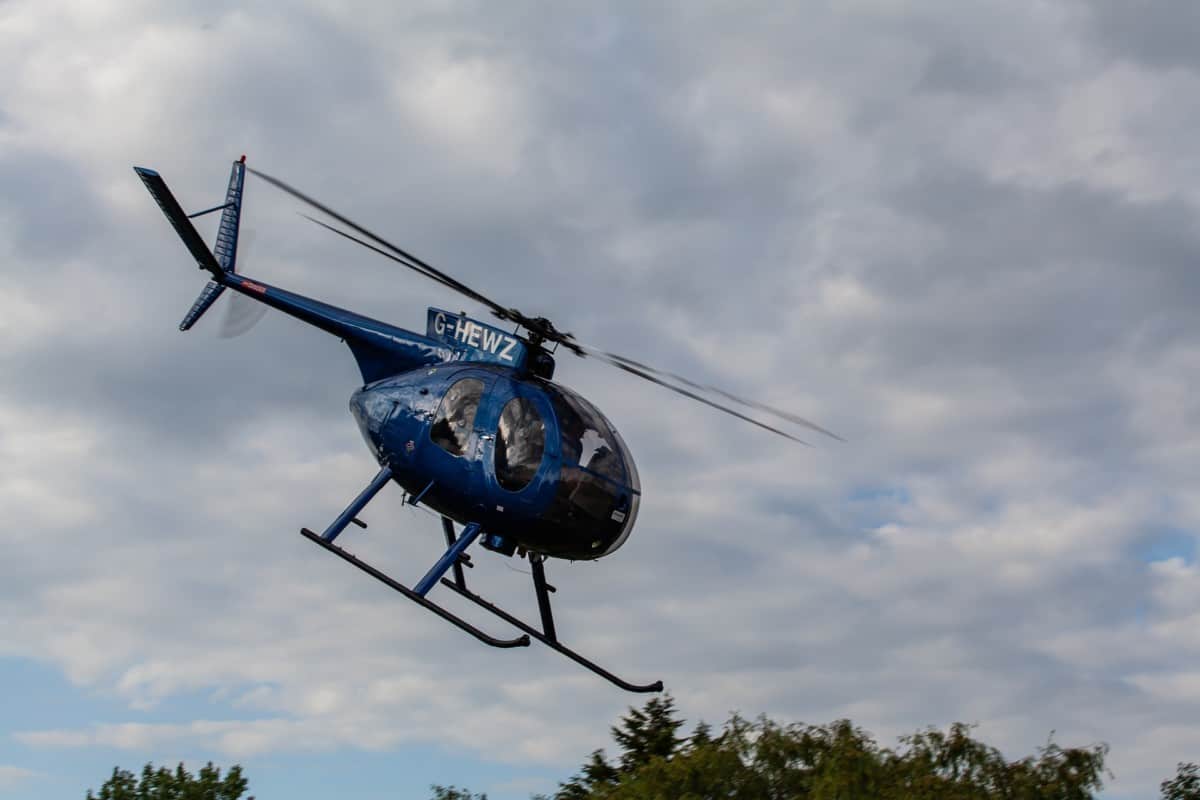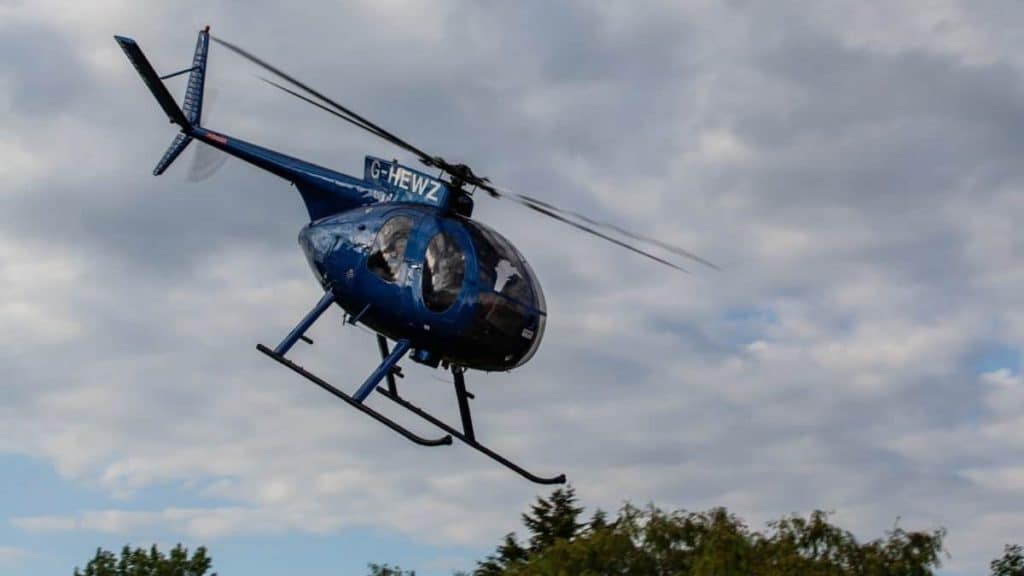
When a helicopter takes off down a runway it seems to be pointing nose down towards the ground as it accelerates. Why does it do that? Airplanes remain flat and then pitch up when taking off, but helicopters seem to point nose down and then go level as they climb. There must be a specific reason for this.
To accelerate, a helicopter needs to tilt its main rotor system forward to create horizontal thrust. The main rotor system is attached to the fuselage so the whole helicopter also points nose down as it accelerates during takeoff. 5°-15° nose down are typical pitch-down attitudes on takeoff.
When a helicopter’s main rotor is turning it forms a disk and it is this disk that aerodynamically controls how the helicopter moves. Because the rest of the helicopter hangs off the rotor system in flight the fuselage is subjected to longitudinal and lateral attitudes as the helicopter flies.
This article is written in a way to try and leave out much of the tough technical jargon and explain it in a ‘Layman’s Terms’ approach.
How Does a Helicopter Accelerate?
Looking at an airplane it is easy to see what makes it move. It either has a propellor or a jet engine providing thrust to push or pull the aircraft through the air:
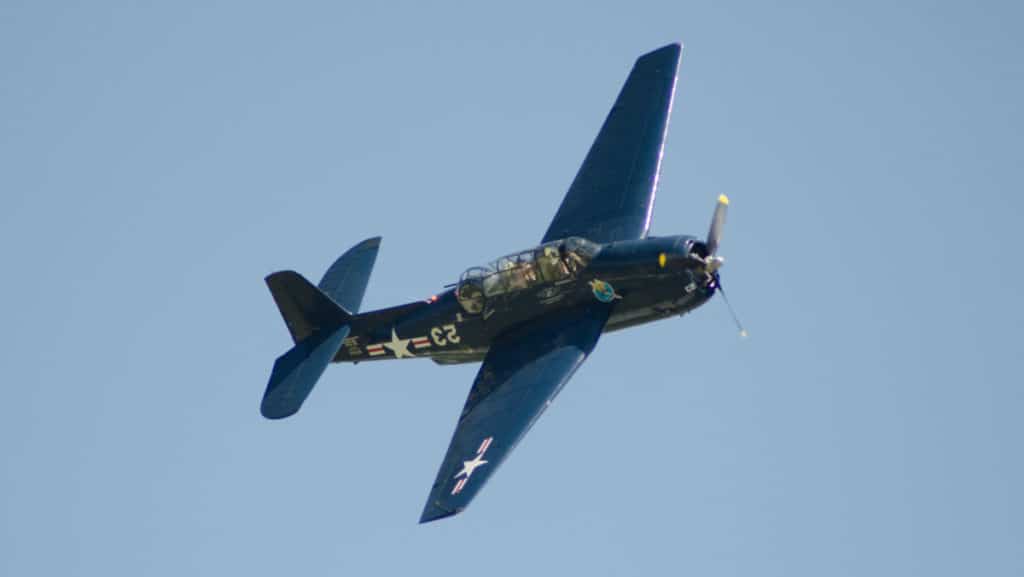
On a helicopter, the thrust and lift are created by the rotating disk that is the main rotor system. The downward force of air from the rotor system creates lift to raise the helicopter into the air and in a no-wind hover that is the only force acting on the helicopter as seen on the right:
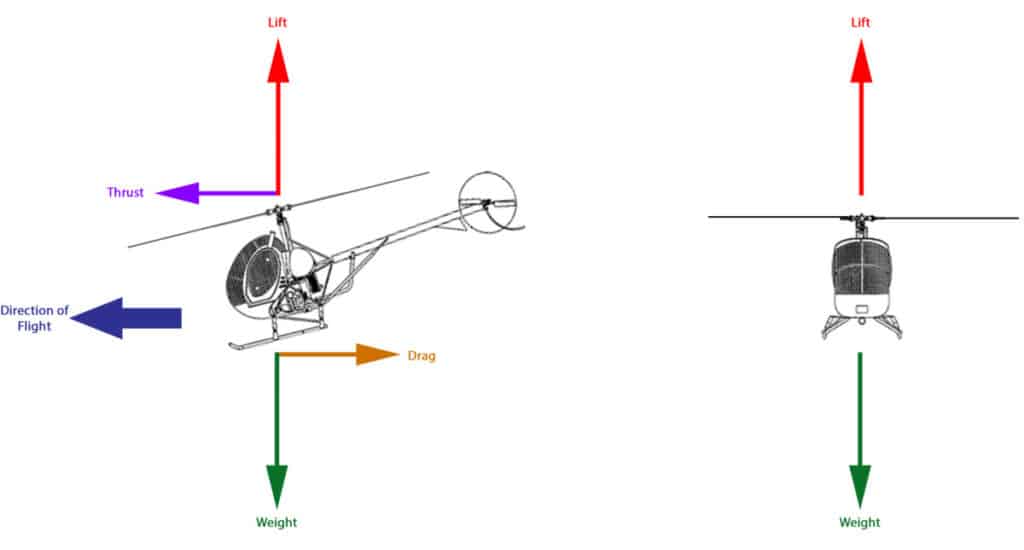
To move the helicopter in any direction, the rotor disk must tilt and begin pushing air in a lateral direction. This is known as thrust. To accelerate the helicopter forward and gain airspeed the pilot must push forward on the cyclic control which tilts the disk forward. This pushes some air from going straight down to now going towards the rear of the helicopter. This then begins to move the helicopter forward.
The faster forward the pilot wishes to go, the more they have to push on the cyclic, which tilts the disk even more. This then pushes more air rearwards propelling the helicopter forwards.
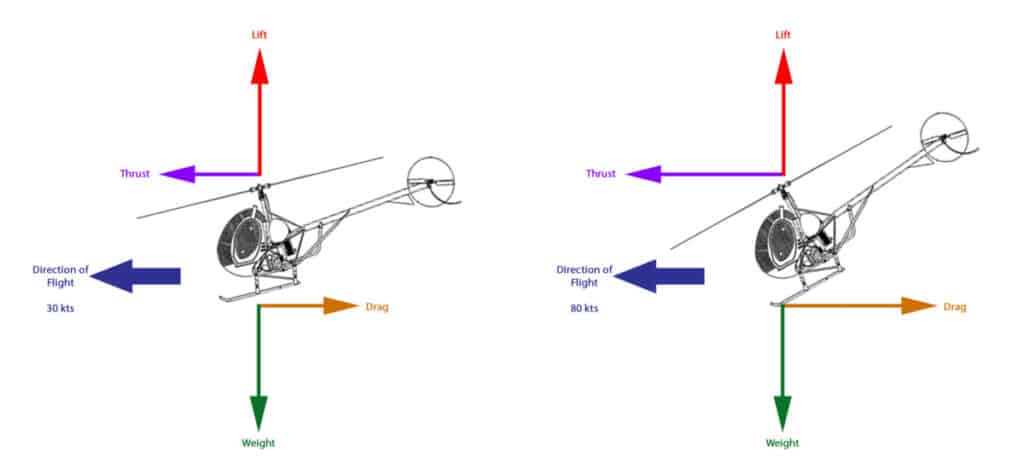
As the helicopter’s speed increases the amount of nose-down attitude increases as you can see in the picture. The other unwanted side effect of increasing speed is the amount of drag acting on the helicopter increases. These two unwanted attributes are some of the issues helicopter designers fight when they want a helicopter to go faster.
This is why a helicopter takes off nose down. The disk needs to be tilted forwards to create a horizontal thrust component to allow the helicopter to accelerate. Because the main rotor disk is connected to the fuselage this makes the nose drop. It is also the same reason why helicopters look like they are pointing nose up when they are coming into land, except at this point the pilot is decelerating the helicopter by tilting the rotor disk aft.

Join My Newsletter & Get Great Tips, Information and Experiences To Help You Become a Superb Pilot!
Helicopter Flat Floor Concept
On smaller helicopters, the main rotor mast is bolted to the helicopter structure at 90°. This means the faster the pilot wishes to go, the more nose down the helicopter has to be for the duration of the flight. I can still remember flying the Schweizer 269 you see in the diagrams above.
That thing flies so slow because of the drag on the canopy that to get anywhere you really had to push the cyclic forward. This led to you practically hanging off your shoulder straps and feeling like you would fall out the front of the helicopter!
For helicopters where the VIP market is a big focus for the helicopter designers the thought of passengers having the feeling of falling out of their seats for a flight would not make a helicopter sell very well!
To get around this the designers create something known as a ‘Flat Floor’ concept and this means that when the helicopter is in cruise, the floor of the helicopter’s cabin is as parallel to the ground as possible. To do this the designers build in an offset into the mounting of the main rotor system which mechanically tilts the main rotor system forward at all times.
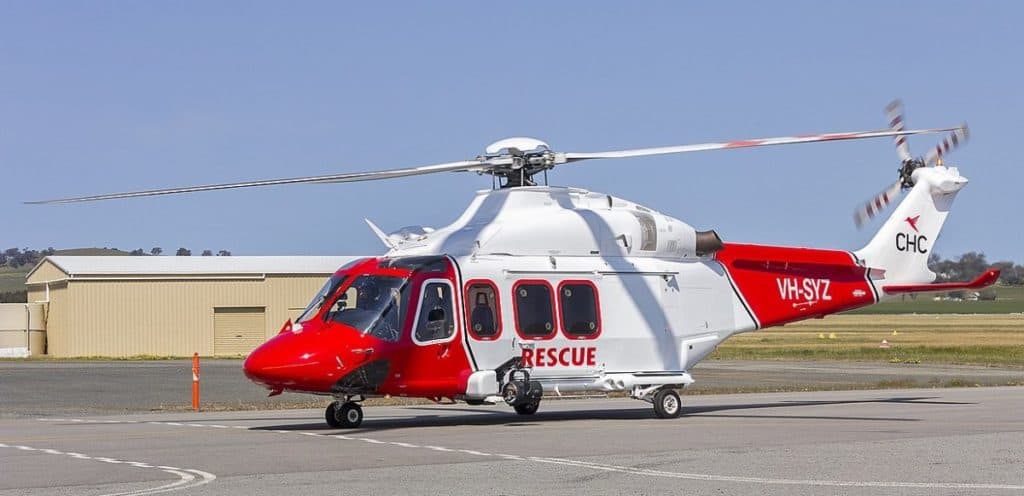
As the helicopter lifts into a hover the fuselage will be pointing nose up as the rotor disk sits horizontal to the ground in a no-wind hover. This makes it harder for the pilot to see, especially when coming into land. The AW129 shown above can sit in a hover with as much as 12-13° nose up. For this reason, most of these types of helicopters are flown in clear environments like helipads and airports.
Trying to land a helicopter like this in a tight confined area, with obstacles and uneven ground always made it tricky. I always had to get the crew to keep their eyes wide open to help ensure I was clear of obstacles.
As the pilot accelerates, the fuselage may pitch from 5-12° nose up to 5-10° nose down for a short while but as the helicopter reaches cruise speed, the mast and rotor system will be tilted forward but the fuselage cabin remains flat. When done smoothly and correctly by a good pilot the passengers will very rarely feel this potential rollercoaster type of maneuver. The flat floor during the majority of the flight is what VIP passengers desire.
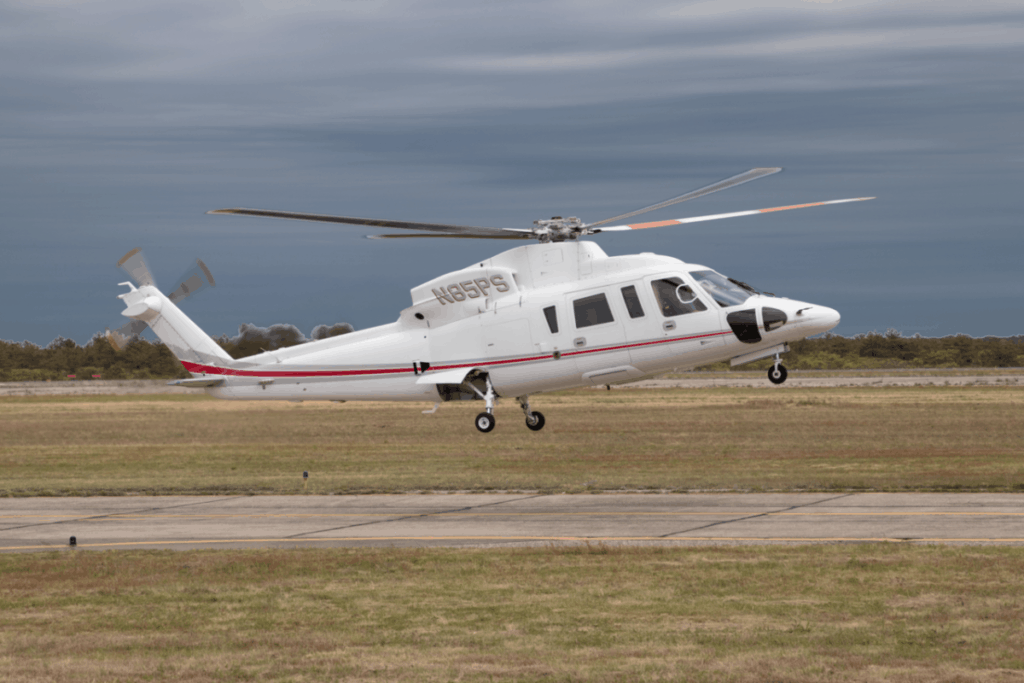
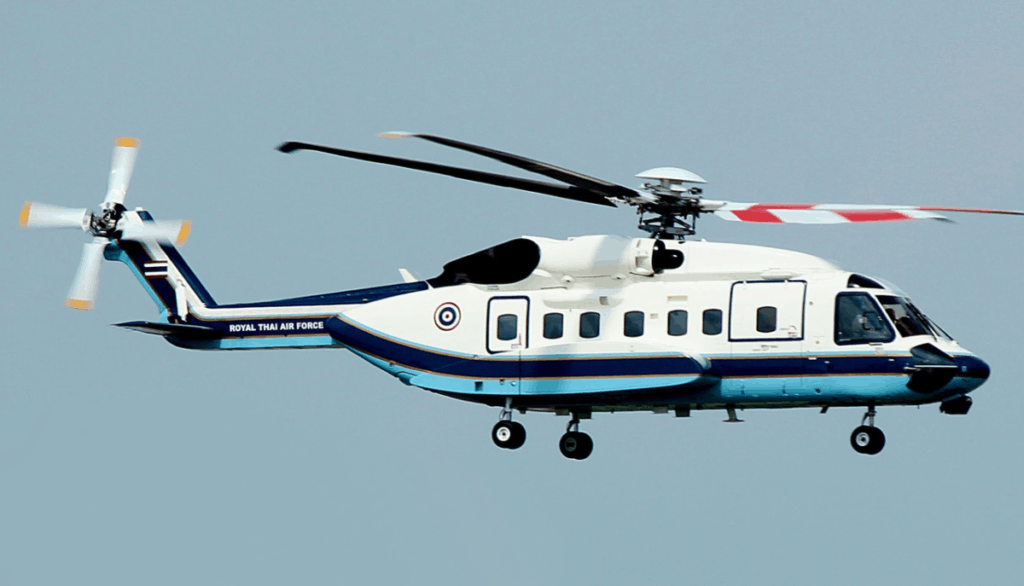
Controllable Stabilator
On the UH-60 Black Hawk the rear horizontal stabilizer, known as a ‘Stabilator’ can move up and down like an elevator on an airplane. The Stabilator is controlled by the helicopter’s Automatic Flight Control System (AFCS) and constantly moves the trailing edge up and down in flight to help improve flight handling for the pilot.
One of the benefits of the Stabilator is that in a hover or at low forward airspeed it is angled downwards to allow the main rotor wash flowing over it to create lift which pulls the tail upwards slightly, helping to keep the fuselage more horizontal to allow the pilots to be able to see more.
In forward flight, the Stabilitors’ trailing edge rises allowing the forward airflow over it to help push the nose of the helicopter down and create the flat floor concept.

There is far more to the stabilator than is warranted in this article but that is the Layman’s terms of how it helps keep the helicopter from pointing nose down during flight.
How Do Helicopters Slow Down?
To slow a helicopter the pilot pulls aft on the cyclic which tilts the main rotor disk backwards. The air being moved through the rotor disk now starts to push the helicopter backward as it flies. The longer this position is held, the slower the helicopter becomes until it stops.
It is pretty much the same as accelerating forward. The pilot has to move the cyclic to control the direction in which the helicopters thust points. When in forward flight the thrust vector is pointing forward as the disk is tilted forward.
To slow down the pilot tilts the disk backward and moves the thrust vector to point backward. This coupled with the drag, then begins to slow the helicopter. If the pilot were to hold the cyclic in the aft position the helicopter would slow down, stop and then begin to fly backwards.
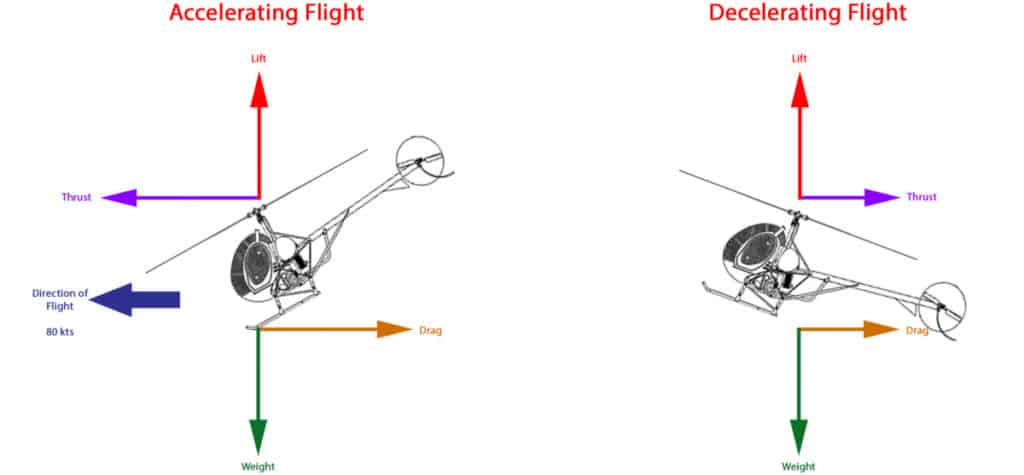
To bring the helicopter to a hover the pilot adjusts the cyclic back to the center just as the helicopter comes to a stop. This way there is no horizontal thrust vector moving the helicopter in any direction.
The faster and further the pilot moves the cyclic aft, the faster and more aggressive the helicopter will slow down. One additional function that happens when the pilot moves the cyclic aft is that the rotor disk will catch the airflow like a sail and will cause the helicopter to climb, or balloon up.
To overcome this the pilot must lower the collective to reduce lift so that as the helicopter begins to balloon up the pilot reduces the lift being produced to remain at the desired altitude, or if they are coming into land the pilot manipulates the cyclic to control the airspeed and the collective controls the rate of descent.
To Finish
Helicopters point nose down when taking off because to accelerate from a hover the main rotor disk needs to tilt forward to create a horizontal component of thrust to propel the aircraft forward. The faster the pilot wishes to accelerate, the more the rotor disk needs to tilt forward which means the more nose down the helicopter points.
Offset masts and stabilators help to keep the amount of nose-down attitude to a minimum, but there will always be some degree of nose-down while the helicopter accelerates.
Further Reading
If you found this article helpful you might these ones too:

